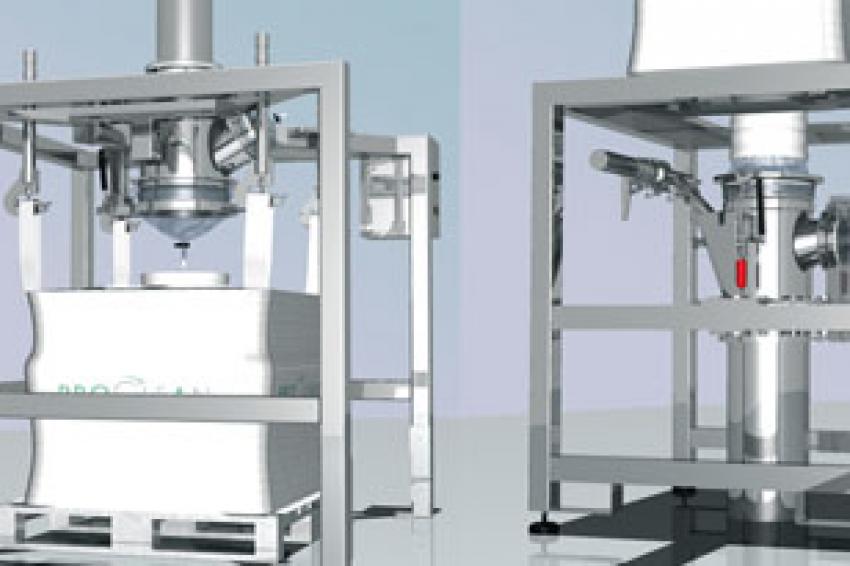Containment Solutions
Closed Systems for Filling and Discharging Big Bags
Safety - In some cases, due to the ongoing increase in their potency, APIs in pharmaceutical production require a containment level of Occupational Exposure Limit 5 (OEL5). Consequently, the operator's safety has to be elevated. So far preference has been given to container systems. However, due to their high purchasing prices and cleaning costs, safe alternatives are being searched for.
In-house transports are often necessary between the individual process steps of pharmaceutical production, such as weighing, mixing, granulating, compressing, coating and packaging. The intermediate products must be filled into bins without hazardous products escaping into the environment and without contamination of the intermediate products.
In the pharmaceutical and API industries the term "containment" is interpreted as Health & Safety for the operator and the product. From the GMP (Good Manufacturing Practice) point of view, containment describes the process of containing a biological agent (medicinal agent/pathogenic factor) or any other substance inside a defined space.
In the pharmaceutical/API industry, even the sampling inspection of the starting materials is problematic, as are the subsequent discharging or filling processes of the solids during operation. The critical interface is often the transfer from transport packages (containers, drums, sacks or Big Bags) to process units. In most cases powders are still transported and stored in drums. The seemingly simple process of discharging drums suddenly turns out to be a difficult task if highly active ingredients are involved, above all in the case of non-free-flowing powder and weights exceeding 50 kilograms.
In the meantime, there is a multitude of possibilities of achieving primary and secondary containment. Secondary containment refers to containment systems that prevent biological agents from escaping to the outside or into other working environments. This includes the use of rooms with special ventilation and the presence of locks and/or sterilizers for passing out materials. In numerous cases, secondary containment can be used to increase the efficiency of primary containment. Examples are clean rooms and laminar air flow cabins.
Primary containment systems prevent dust (biological agent) from escaping into the environment. These include systems that efficiently prevent dust from escaping when the package is changed. In a permanently closed process, no cross contamination can happen. The rooms used for solids handling no longer need to be that complex. It is no longer mandatory to integrate complex personnel and material locks to avoid cross contamination. The operators do not have to undergo a decontamination process to avoid cross contamination via their clothes.
Containment Classification
The Containment classification ranging from OEL1 to OEL5 is defined according to the toxicity and potency of the product. While in the OEL1 range, open systems with local evacuation may be employed. The systems have to become more and more contained as the OEL increases. Products with an OEL5 must be handled with special equipment only.
APIs or pharmaceuticals with an OEL5 are very critical, not even the tiniest part of them is allowed to be released. For the highest containment requirements, methods of primary and secondary containment are combined. Operations during which small quantities of dust may escape are performed in an isolator using gloves.
Why So Expensive?
The containers used in the implementation of these high containment requirements are made of high quality stainless steel. However, an enormous cost factor is the containment system located both at the inlet and the outlet. No product residues whatsoever must be released in the shut-off position. For precautions an enormous technical effort is necessary at the filling/discharge stations and at each container, which not only makes containers themselves very expensive but also their maintenance and plant engineering.
Big Bag Alternative?
The cleaning and maintenance of containers is expensive. Washing cabins must be provided and contaminated cleaning fluids must be disposed of. Alternatively Big Bags do not require any storage, maintenance or cleaning.
The core of the Big Bag discharge station is a docking system that allows the Big Bag outlet to connect with two integrated liners to the isolator. A workplace limit smaller than 200 ng/m³ can be achieved. The outer liner is connected to the outside of the isolator and the connection is checked in a tightness test. The inner liner is connected to the product tube inside the isolator via gloves. An RTP (Rapid Transfer Port) permits the parts in the isolator to pass out and pass in small quantities for discharge into the process.
Patented Liner Systems
Liner filling heads are used for filling, liner connecting systems for discharging FIBCs (Flexible Intermediate Bulk Containers). These systems require Occupational Exposure Band 2-4 (OEB 2-4). The operator disposes of the shower cap of the preceding conversion via a lateral hand hole, where a removal sack is connected as a disposable glove. Systems like this can be provided with a CIP (clean-in-place) system for inline cleaning. During product flow and cleaning, the lateral hand hole is additionally closed.
For filling the final product into a liner in a closed system, an endless liner of approximately 30 meters is provided centrically below the product outlet. The operator pulls the closed liner down to the bottom of the mini bag, drum, carton, etc.. The endless liner is filled and then closed and cut twice. The liner and the product outlet are always closed towards the environment. When the liner has been used up, the liner cartridge will be replaced contamination-free.
Modified Big-Bag Solibag
Solibags, which require OEB 2-3, allow a semi-automatic filling and an automatic discharge of Big Bags. In order to do so, passive metering valves are integrated into a Big Bag. Via the passive valve, the Big Bag is docked to an active metering valve with lifting cone mechanism. A partial discharge and the metering directly from the Solibag are possible. The cones pressed into the Big Bag are reusable.
The docking systems of cone-containers and Solibag are equal in terms of function and safety. Due to its flexible jacket, the Solibag is more suitable for the discharge of bridging product. Moreover, for the transportation of tablets the Solibag is most convenient.
Big Bags are approved for the transportation of hazardous materials on rail, ship and truck. In terms of operational costs and purchase price, the use of Big Bags may substantially contribute to cost reduction.






